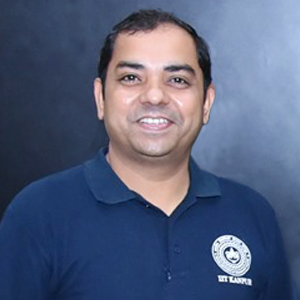About
Machine Learning (ML) and Artificial Intelligence (AI) are transforming the workplace. It refers to the process of developing self-learning algorithms by way of simple data input. The goal of machine learning is to increase accuracy. It does this by optimizing the execution of a job from knowledge gained by operating through linked datasets. Any addition to the accuracy of a particular use offers up a world of advantages, especially with industry.
Certificate You Will Get
For applying for a job Machine Learning + Artificial Intelligence certificate is considered one of the most needed certifications.
Training Highlights

Learn from home
Stay safe indoors

Certificate of Training
From Prutor.ai

24+ video tutorials
Learn anytime, anywhere

600+ Coding Problems
Practice

6 weeks access
To the platform

Syllabus
Comprehensive syllabus of AIML covered

Doubt clearing
Through Q&A forum

24X7 Access
View lectures as per your own convenience

Beginner friendly
No prior knowledge required

Online lectures
Online lectures with high-quality videos
Why Learn Machine Learning?

Behavior Prediction
Insightful Business Intelligence

Improved Customer Satisfactions

The End of Menial Tasks

Increased Sales Opportunities
How will your training work?
1
Watch the video
2
Hands-on practice in virtual lab
3
Do project work
4
Give final quiz
5
Get a certificate in AIML
Choose the Language
AI + ML (Hindi + English)
Self-Paced Learning With Faculty Support and Virtual Lab
Key Features
- Lectures in Hindi + English
- Slides in English
- Price@Rs. 8000 + 18% GST
- Online lectures: 40 hours of online lectures with high-quality videos.
AI + ML (English)
Self-Paced Learning With Faculty Support and Virtual Lab
Key Features
- Lectures in English
- Slides in English
- Price@Rs. 8000 + 18% GST
- Online lectures: 27+ hours of online lectures with high-quality videos.
Demo of Mixed Language Course
Demo of English Language Course
COURSE CURRICULUM
AI + ML (Language: Hindi + English)
- What is ML?
- Examples of ML
- Types of ML
- Introduction to the basic terminology
- ML package :scikit-learn
- Anaconda
- How to install anaconda
- Introduction to NumPy
- Creating an array
- Class and Attributes of ndarray
- Basic Operations
- Activity-Slice
- Stack operations
- Mathematical Functions of NumPy
- Introduction to Pandas
- Understanding DataFrame
- Series
- Concatenating and appending DataFrames
- loc and iloc
- Drop columns or rows
- Groupby
- Map and apply
- Introduction
- Dealing with missing data
- Handling categorical data
- Encoding class labels
- One-hot-encoding
- Split data into training and testing sets
- Bringing Features onto the same scale
- Introduction
- Simple Linear Regression
- Multiple Linear Regression
- Polynomial Regression
- Evaluate Performance of a linear regression model
- Overfitting and underfitting
- Regularization
- Predicting prices for housing Boston dataset
- KNN theory
- Implementing KNN with scikit-learn
- KNN Parameters
- n_neighbors
- metric
-
- How to Find Nearest Neighbors
- Writing Own KNN classifier from scratch
- Logistic Regression theory
- Implementing Logistic regression with scikit-learn
- Logistic Regression Parameters
- Multi-class classification
- MNIST digit dataset with Logistic Regression
- Predictive modeling on adult income dataset
- SVM theory
- Implementing SVM with scikit-learn
- SVM Parameters:
- C and gamma
- Plot hyperplane for linear classification
- Decision function
- The theory behind the decision tree
- Implementing a decision tree with scikit-learn
- Decision tree parameters
- Combining multiple decision trees via Random forest
- How random forest works..?
- Theory Naive Bayes Algorithm
- Features extraction
- Countvectorizer
- TF-IDF
- Email Spam filtering
- Sentiment analysis
- Cross-validation via K-Fold
- Tuning hyperparameters via grid search
- Confusion matrix
- Recall and Precision
- ROC and AUC
- K-means Clustering
- Hierarchical Clustering
- Elbow method
- Principal components analysis(PCA)
- PCA step by step
- Implementing PCA with scikit-learn
- LDA with scikit-learn
- Email-Spam filtering integrated with Django
- Sentiment analysis on web app
- News classification
AI + ML (Language: English)
- Introduction To Machine Learning
- History and Evolution
- Artificial Intelligence Evolution
- Find out where Machine Learning is applied in Technology and Science.
- Supervised Learning
- Unsupervised Learning
- Data Analysis Packages
- NumPy
- SciPy
- Matplotlib
- Pandas
- Slkearn
- Regression
- Classification
- Generalization, Overfitting, and Underfitting
- Classification
- Understand how continuous supervised learning is different from discrete learning.
- Code a Linear Regression in Python with scikit-learn.
- Understand different error metrics such as SSE, and R Squared in the context of Linear Regressions.
- k-Nearest Neighbor
- Linear models
- Naive Bayes Classifiers
- Decision trees
- Support Vector Machines
- Challenges in unsupervised learning
- Preprocessing and Scaling
- Applying data transformations
- Scaling training and test data the same way
- Principal Component Analysis (PCA)
- A revolution in Artificial Intelligence
- Limitations of Machine Learning
- What is Deep Learning?
- Advantage of Deep Learning over Machine learning
- How Deep Learning Works?
- Activation Functions
- Training a Perceptron
- TensorFlow code-basics
- Tensorflow data types
- Tensorflow methods
- Introduction to Neural Networks
- Neural Network Architecture
- Linear Regression example revisited
- The Neuron
- Neural Network Layers
- The MNIST Dataset
- Coding MNIST NN
- Understand the limitations of a Single Perceptron
- Deepening the network
- Convolutional Neural Networks
- ConvNet Architecture
- Overfitting and Regularization
- Max Pooling and ReLU activations
- Dropout
- Strides and Zero Padding
- Coding Deep ConvNets demo
- Visualizing NN using Tensorflow
- Tensorboard
- How to compose Models in Keras
- Sequential Composition
- Functional Composition
- Predefined Neural Network Layers
WHAT PROJECT YOU CAN BUILD?

Titanic Survival Prediction

Fake News Detection

Heart Attack Detection

Brain Tumor Detection
How will your doubts get solved?
 You can post your doubts on the Q&A forum which will be answered by the teachers within 24 hours.
You can post your doubts on the Q&A forum which will be answered by the teachers within 24 hours.
Course Designed and Developed by
Prof Amey Karkare
Faculty in Department of CSE, IIT Kanpur
Rahul Garg
25+ year of IT Industry work experience in India & abroad
Review
"Overall Very Good. More focus is given to practical exposures of subject. Coding part that is required is nicely taught here. All the topics are taught from the basics to advanced level so that every branch of engineering student can understand the topics easily. Last but not the least, faculties clear your every small doubt of students and are always ready to help every students in every possible way. So overall this is a good platform where we learn machine learning like subjects easily without any hesitation."
"Totally satisfied with the course. Everything was nice and upto mark. Great course and great mentors."
"This is one of the best course i have ever done.I'm going to recommend this course to my those friends who are interested in AI and ML"
"Faculties are awesome. They teachs every little thing very smoothly. It is easy to understand big problems through your resources."
"The syllabus coverage was prettey good and the faculty was also very good."
"All the algorithms explained in very simple way."
"It was awesome experience."
"ML is a vast field and I learn that there are myriad scopes in this field. Learning new concepts and working upon techniques to build models was really interesting. The session was informative and a lot of concepts were cleared. Hands on experience was also gained. Had a productive and wonderful time!"










